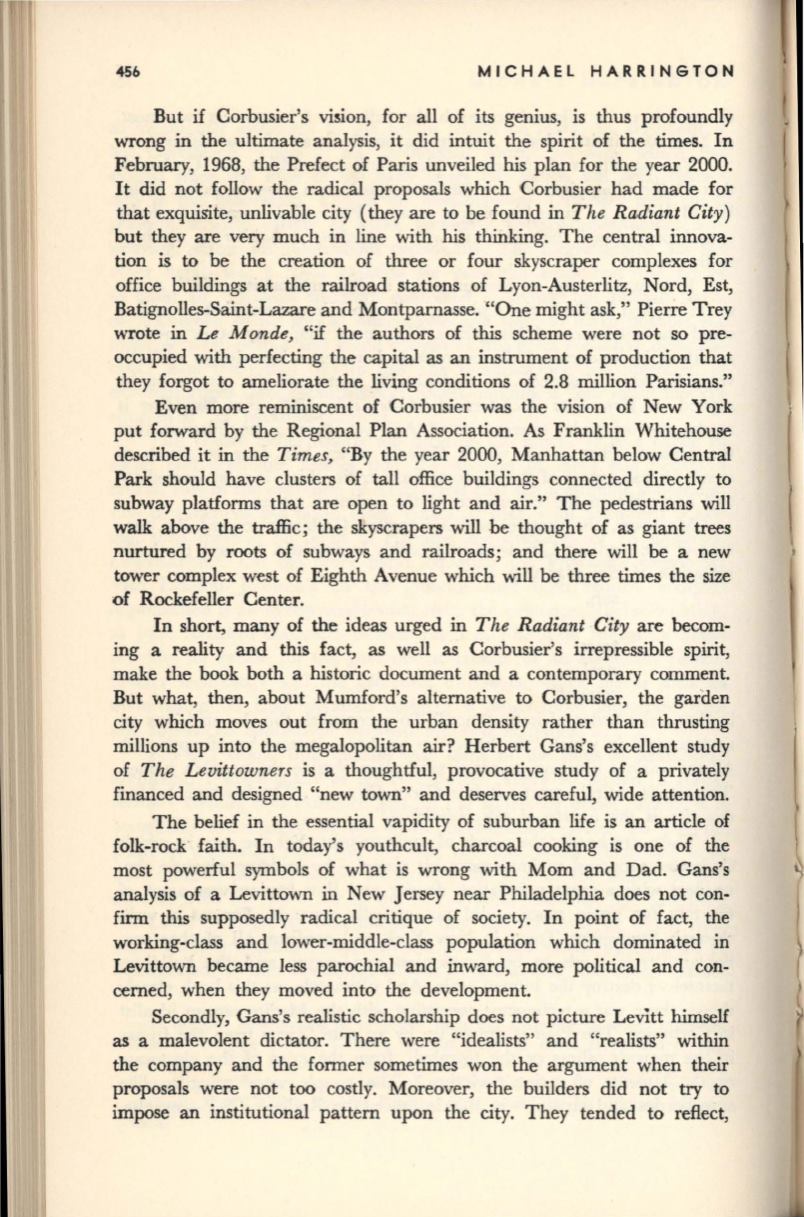
-456
MICHAEL HARRINGTON
But if Corbusier's VlSlon, for all of its genius, is thus profoundly
wrong in the ultimate analysis, it did intuit the spirit of the times. In
February, 1968, the Prefect of Paris unveiled his plan for the year 2000.
It did not follow the radical proposals which Corbusier had made for
that exquisite, unlivable city (they are to be found in
The Radiant City)
but they are very much in line with his thinking. The central innova–
tion is to be the creation of three or four skyscraper complexes for
office buildings at the railroad stations of Lyon-Austerlitz, Nord, Est,
Batignolles-Saint-Lazare and Montparnasse. "One might ask," Pierre Trey
wrote in
Le Monde,
"if
the authors of this scheme were not so pre–
occupied with perfecting the capital as an instrument of production that
they forgot to ameliorate the living conditions of 2.8 million Parisians."
Even more reminiscent of Corbusier was the vision of New York
put forward by the Regional Plan Association. As Franklin Whitehouse
described it in the
Times,
"By the year 2000, Manhattan below Central
Park should have clusters of tall office buildings connected directly to
subway platforms that are open to light and air." The pedestrians will
walk above the traffic; the skyscrapers will be thought of as giant trees
nurtured by roots of subways and railroads; and there will be a new
tower complex west of Eighth Avenue which will be three times the size
of Rockefeller Center.
In short, many of the ideas urged
in
The Radiant City
are becom–
ing a reality and this fact, as well as Corbusier's irrepressible spirit,
make the book both a historic document and a contemporary comment.
But what, then, about Mumford's alternative to Corbusier, the garden
city which moves out from the urban density rather than thrusting
millions up into the megalopolitan air? Herbert Gans's excellent study
of
The Levittowners
is a thoughtful, provocative study of a privately
financed and designed "new town" and deserves careful, wide attention.
The belief in the essential vapidity of suburban life is an article of
folk-rock faith. In today's youthcult, charcoal cooking is one of the
most powerful symbols of what is wrong with Mom and Dad. Gans's
analysis of a Levittown in New Jersey near Philadelphia does not con–
firm this supposedly radical critique of society. In point of fact, the
working-class and lower-middle-class population which dominated in
Levittown became less parochial and inward, more political and con–
cerned, when they moved into the development.
Secondly, Gans's realistic scholarship does not picture Levitt himself
as a malevolent dictator. There were "idealists" and "realists" within
the company and the former sometimes won the argument when their
proposals were not too costly. Moreover, the builders did not try to
impose an institutional pattern upon the city. They tended to reflect,
•


